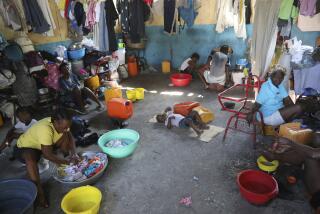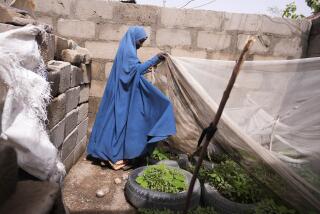Food Price Increases Hurt : Ethiopian Cities May Be Next to Feel the Famine
- Share via
ADDIS ABABA, Ethiopia — Relief officials, who have been focusing attention on drought-stricken rural areas of Ethiopia, now are voicing concern about malnutrition in the nation’s cities, including this capital.
The officials say sharp increases in commodity prices--as much as 250% for some grains since last year--have made it difficult for many city dwellers to buy either the quality or quantity of food needed for a proper diet.
‘Deteriorating Drastically’
“Nutritional standards are deteriorating drastically, especially for children,” said Frank Carlin, director in Ethiopia for the New York-based Catholic Relief Services.
The official Addis Ababa price of tef , a wheat-like Ethiopian grain, has risen from 1 birr (50 cents) a kilogram (2.2 pounds) last year to 2.50 birr ($1.25) now because the drought reduced nationwide grain supplies. Many poor families in the cities are basing their diets on corn, which has almost doubled in price in the same period.
Municipal officials in Addis Ababa have appealed for assistance, while neighborhood chapters of the government-organized Urban Dwellers Assn. have begun distributing emergency rations to the destitute, and the national government reportedly has spent about $65 million in the last year to import grain for the cities.
May Get ‘Frighteningly’ Worse
However, Carlin said the problem will get worse--”frighteningly so”--unless help comes from abroad to supplement the regular flow of famine aid.
Ethiopia’s Relief and Rehabilitation Commission has acknowledged that malnutrition exists in the capital and other urban areas but says its primary duty is to assist the direct victims of the drought and famine.
Berhane Deressa, the deputy relief commissioner, suggested wryly that the government might have been accused of “criminal diversion” if it had shifted donated food from the countryside to Addis Ababa.
He said the government had concentrated its relief efforts on rural areas, where more than 90% of Ethiopia’s 42 million people live, to avoid increasing migration to the cities and aggravating employment and health problems there.
Steve Reynolds, a spokesman for the U.S.-based relief agency World Vision, said that in some of Addis Ababa’s poorest neighborhoods more than half the children have thin limbs, bloated stomachs or other signs of malnutrition.
Struck By Conditions
Steve Rothman, associate director of the Asolo State Theater of Florida and a member of the Christian Children’s Fund board of directors, said he was struck by the poor conditions of some Addis Ababa neighborhoods where he and a film crew recently shot television appeals for contributions.
“The images on camera are very different from the relief centers that have been shown so often,” he said.
“But I think people will realize that there’s a whole other problem here.”
More to Read
Sign up for Essential California
The most important California stories and recommendations in your inbox every morning.
You may occasionally receive promotional content from the Los Angeles Times.










